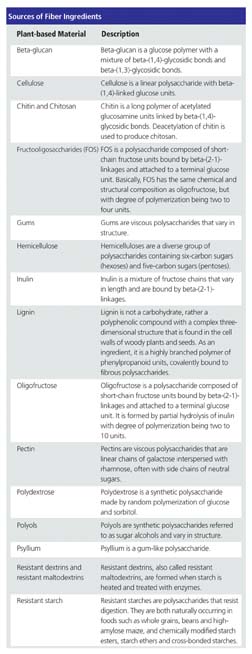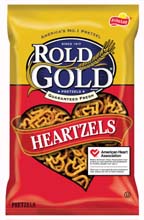
Thanks to initiatives by major food companies, the eating trend for the next few years will be improved health and portion control (about time!!!). Three biggies-General Mills Inc., Minneapolis, Kraft Foods Inc., Northfield, Ill., and PepsiCo Inc., Purchase, N.Y.-are on board with introductions ranging from formulation improvements to sweetened breakfast cereals, to turning calorically dense American institutions into snacking options for calorie counters (see sidebar).
Pepsi's corporate leader of health and wellness, Brock Leach, recently told New Nutrition Business that "the issue is making healthful options convenient, easily accessible and good tasting. Good-tasting conveniences are our forte. So we see this as a growth opportunity for taking everything we have in our packaging systems, supply chains and distribution systems and use that to provide a healthier product offering." He further points out that wellness will be to the food industry what convenience was over the past 15 years.

Fiber's place in the big picture
"There has been a resurgence of interest in fiber as a result of the low-carbohydrate trend," says Kathy Niness, v.p. of marketing and sales, Orafti Active Food Ingredients, Malvern, Pa. "Food and beverage manufacturers, including dairy processors, view fiber as a healthful, effective way to reduce carbohydrate levels in foods naturally."Even though this trend has slowed, the demand for fiber will remain strong for a variety of reasons. "Reduced-carbohydrate, and thus lower-glycemic diets are here to stay and are beginning to be recognized by diabetes doctors as a healthful way to control blood sugar," adds Niness. "There's also an emerging consumer understanding of digestive health."
Indeed, fiber's importance to overall health and well-being will continue to fuel market growth for products with added fiber.
"Fiber's role in nutrition is more than just adding bulk," says Linda Douglas, scientific affairs mgr., GTC Nutrition, Golden, Colo. "There are many types of fiber, both soluble and insoluble, that are increasingly being recognized for their individual merits, including aiding blood sugar control, weight maintenance, mineral absorption and overall maintenance of good health."
Donna Brooks, product mgr., Danisco Sweeteners, Ardsley, N.Y., says, "A positive result of the low-carb dieting phenomenon is that many consumers have become aware of the way their bodies metabolize different foods, such as sugars and starches. They are also learning that not all carbohydrates raise blood glucose levels and some actually play an important role in their diet."
There's no argument, the counting carbohydrates craze made consumers aware of the fact that not all carbs are created equally.
"The changing perspective of dietary fiber has been dramatic," says Rhonda Witwer, business development mgr., nutrition, National Starch Food Innovation, Bridgewater, N.J. "More recently, fiber has become a primary focus of public health authorities. In fact, the Dietary Guidelines Advisory Committee has cited fiber as one of only seven ‘nutrients of concern.' This is because of the wealth of fiber's health benefits that apply directly to today's biggest concerns, which are cancer, diabetes, heart disease and obesity."
Douglas adds, "The multifunctional actions of food fibers and the various application possibilities that are available with both conventional and novel fibers allow food producers to bring extra value and health benefits to the consumer."

Some fiber facts
A few years ago, the U.S. National Academy of Science established the first Dietary Reference Intakes for dietary fiber. For adult females, it is 25g per day, while for males it is 38g. Unfortunately, median intakes are about half of this for each gender.This gap in meeting recommended dietary fiber intakes, along with the recently released Report of the U.S. Dietary Guidelines Advisory Committee on Dietary Guidelines for American's, has created an incredible opportunity for fiber-enriched products, including dairy foods.
What do the new dietary guidelines have to say about fiber?
This scientifically dense report (500-plus pages), which replaces the 2000 guidelines, dictates federal nutrition policy. The new report offers advice for portion control, reemphasizes the benefits in consuming fruits, vegetables and whole grains, and offers direction for long-term healthful dieting. The report will also be used to overhaul the controversial Food Guide Pyramid, which will be updated later this year.
With fiber guaranteed to be emphasized in eating recommendations issued this year, food and beverage manufacturers are seeking out ways to boost fiber levels to noteworthy levels. The good news for dairy processors is that there are a variety of fiber-enriching ingredients available that can be added undetectably to dairy foods. Such fiber ingredients are odorless, flavorless and inert.
Dietary fiber ingredients are typically plant-derived and are categorized as insoluble or soluble. Dietary fiber ingredients described as insoluble often contain cellulose, hemicellulose, lignin or resistant starch; whereas many soluble fiber ingredients contain fructooligosaccharide (FOS), gum, inulin, pectin, polydextrose or resistant maltodextrin. (See table for a list of dietary fiber ingredient sources.)
"Different fibers deliver different benefits," says Witwer. "And consumers will continue to gain a better understanding regarding which fibers provide particular functions in the body."
Insoluble fiber is associated with reducing the risk of digestive disorders, as well as certain cancers. Insoluble fiber acts as a laxative, as it adds bulk to stool, hastening passage of fecal material through the gut. Soluble fibers that are fermentable confer the same benefits, but they do so through probiotic bacteria support in the intestine and are thought to be gentler on the digestive system.
Insoluble dietary fibers are typically used in the grain-based foods industry; however, suppliers have adapted some insoluble fibers for use in dairy foods. Thus far, however, most dairy products flagging dietary fiber contents have relied on soluble fiber sources.
Soluble fibers have been shown to trap dietary cholesterol and bile acids as they pass through the gastrointestinal tract, helping the body eliminate cholesterol and reduce blood cholesterol levels. They have also been shown to trap carbohydrates, slowing their digestion and absorption. This may help prevent wide swings in blood sugar level during the day, as well as have an impact on the development of adult-onset diabetes. This is where glycemic index comes into play.
Glycemic index is a ranking of carbohydrates on a scale from 0 to 100, depending on how much the carbohydrate raises blood sugar levels after eating. Foods with a high-glycemic index are rapidly digested and absorbed and result in big fluctuations in blood sugar levels. But foods with a low-glycemic index, by virtue of their slow digestion and absorption, such as fiber ingredients, produce gradual rises in blood sugar and insulin levels.
Some soluble fibers have also been shown to boost calcium absorption and act as prebiotics to promote the growth of beneficial intestinal bacteria (probiotics). This renders these soluble fibers as a natural addition to cultured dairy products, where calcium is inherently present and formulations often contain probiotic cultures.
"The dairy industry is particularly well suited to capitalize on the newer forms of fiber, such as NutraFlora® short-chain fructooligosaccharides (scFOS®)," says Douglas. "Dairy products are popular, widely consumed and provide a variety of essential nutrients. Adding fiber to this winning mix can only accentuate and enhance the desirability of dairy products."
Some yogurts in the marketplace are made with certain well-documented and researched soluble fibers. As a result, these yogurts have attractive label statements that discuss enhanced calcium absorption, enhanced immune function and probiotic support properties.
"Such statements are well understood and valued by consumers," adds Douglas.
As mentioned, fiber ingredients vary and food manufacturers have several options. "Litesse® polydextrose is a prebiotic fiber that contributes to optimal digestive health and has specific beneficial effects on the intestinal microflora," says Brooks. "It has a sustained prebiotic effect throughout the entire intestine and it is well tolerated by the human body. And, while contributing to digestive health, Litesse also reduces calories and enhances the flavor and texture of many dairy foods."
Orafti markets a variety of fiber ingredients, all of which have application in dairy foods. "Raftiline® (inulin) and Raftilose® (oligofructose) can be used to replace fat and sugar in food and beverage applications without adversely affecting taste or mouthfeel," says Niness. "At the same time they improve calcium absorption and enhance gastrointestinal health by functioning as a prebiotic.
"We also have Raftilose Synergy 1, which offers enhanced calcium absorption at lower use levels," Niness adds.
TIC Gums, Belcamp, Md., has long touted the benefits of the dietary fiber found naturally in gums. "Gums have always been an excellent source of soluble dietary fiber. Compared to 12% soluble fiber found in oat fiber, water-soluble gums contain at least 80% soluble fiber and do not drastically alter the finished viscosity or flavor of a product," says Florian Ward, v.p. of research and development. "Gums are also multifunctional in that they supply dietary fiber as well as work to reduce low-density lipoprotein (LDL), or ‘bad' cholesterol levels, inhibit atherosclerosis, speed oral rehydration and improve insulin response."
With many fiber ingredient options, product developers must keep in mind that there are two nutrient descriptor claims available to them for touting fiber contents. A food may claim to be a "good" source of fiber if it contains 2.5g of fiber per serving. It may be considered a "high" source if it contains 5.0g of fiber per serving. Serving sizes vary depending on the food.
In conclusion, Americans will undoubtedly make a carbohydrate correction in the next few years. Add value to your company's dairy foods by boosting fiber contents.

Sidebar: Look What's Going on in the Marketplace
It's finally happening. What, you ask? Food and beverage marketers are offering and promoting products for responsible and healthful eating.For example, PepsiCo's Frito-Lay® Rold Gold® Heartzels™ Pretzels meet the American Heart Association's "heart check mark" guidelines as a heart-healthy food. The pretzels contain no saturated fat, no cholesterol, less sodium than regular pretzels and have been formulated to be a good source of fiber and iron. Other "healthful" Frito-Lay snacks sport the company's Great Taste Smart Snack™ ribbon.
Also, PepsiCo has changed the name of its Diet Sierra Mist® to Sierra Mist Free. "The new name highlights what has always been true-Sierra Mist Free is free of the things you don't need," says Steve Sears, v.p. of marketing for flavors, Pepsi-Cola North America. "We're giving people a better understanding of the benefits of Sierra Mist Free while also reengaging current diet consumers and attracting new people to the brand."
All General Mills cereals have been reformulated to include significant levels of whole grains. This improvement single-handedly is projected to increase the number of whole grain servings per year for Americans by more than 1.5 billion, and without adding calories to the diet. And, some of Kellogg's® cereals now come with one-third less sugar.
Kraft has taken many of its Nabisco®-branded snacks, performed a little R&D and transformed them into 100 Calorie Packs.
Finally, who would have thought you could ever substitute a side salad for French fries (for no extra charge) in a Wendy's Old Fashioned Combo®?
The future looks much healthier for Americans.